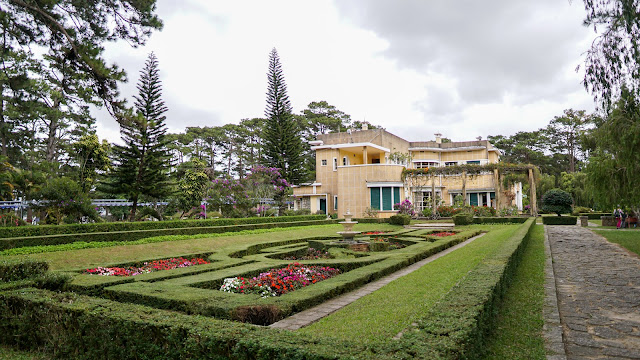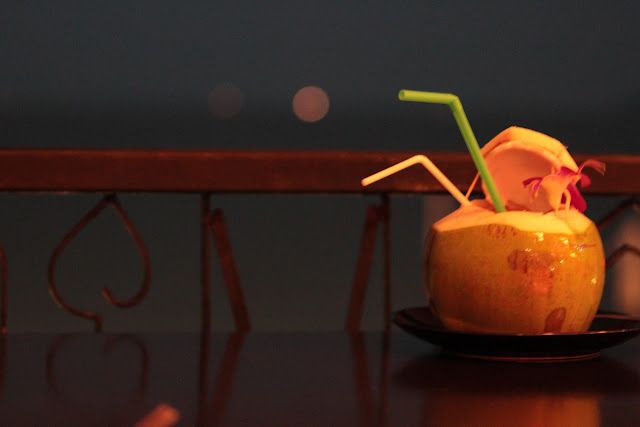 |
| Bao Dai is the last emperor of the Nguyen Dynasty in Vietnam’s feudal regime. When mentioning about Bao Dai Summer Palace, there are, actually, three palaces which are the First, Second and Third Palace, all are located in Da Lat City, a charming romantic paradise. However, the third palace is much more famous and beautiful than the other two ones, so people usually call it Bao Dai Palace for shortening. |
|
 |
| Bao Dai Palace (Palace III) was constructed by a French architect and Vietnamese architect Huynh Tan Phat during 6 years, from 1933 to 1938. The palace was surrounded with Ai An forest on the hill-top, under Dalat embellishment project for head-of-state Palace by Hébrard. The entire building is deeply influenced by European architectures with a harmony between pine forests and parks. This is an incredibly elegant mansion, nested in poetic scenery of a pine hill at an altitude of 1.539m above sea level. |
 |
| Bao Dai was the 13th and last emperor of the Nguyen Dynasty, the final dynasty of Vietnam ruling 143 years. He succeeded as emperor in 1926, and abdicated in 1945 when he was ousted by the French. He self-exiled to France in 1956, where, having spent most of his fortune, he lived a modest existence. He died in 1997 at the age of 85. |
 |
| Bao Dai Summer Palace was designed with 25 rooms using a system of well-disposed flat roofs. After entering the main entrance of the palace, you will feel the fresh air and the tranquility right then thanks to the little lovely garden in front of the palace together with the cool temperature there. The palace has two floors. |
 |
| The ground floor was for parties and meetings with foreign guests and government officials. There also includes working rooms, Bao Dai’s office, a library, rooms for entertainment and a large dining room. |
 |
| From 1949, when the Queen Nam Phuong took her children to France, Bao Dai had some relations with 3 concubines: Bui Mong Diep, Phi Anh and Jenny Wong (from Hong Kong). |
 |
| After the King had gone in exile in France, Place III became the holiday home of Ngo Dinh Diem and then Nguyen Van Thieu. |
 |
| For years, the Palace had been under the management of the People's Committee of Lam Dong province in management and has just assigned to Xuan Huong travel service Company managing from mid-2000. |
 |
| Bao Dai Palace is one of the unique European architecture. It also contains numerous precious royal antiques. It is currently appealing attraction in Dalat - Flower City. |
 |
| Upstairs is the living space of the king and his family, including the King's bedroom, the Queen Nam Phuong's bedroom, princes' rooms, princesses' rooms, and galleries on family photos and daily items. |
 |
| Particularly, near the bedroom of the King stands a beautiful tower called Vong Nguyet (The Watching Moon Balcony), where the King and the Queen enjoy the moonlight. |
 |
| This is the bathroom which they do have a bidet in each of their bathrooms. The furniture and renovations are getting aging year by year which no longer able to see how grand it was back then. |
 |
| Inside the palace, there are many valuable items still preserved in good condition. They include several sculptures of royal family, the life-size white bust of Bao Dai himself and a smaller gold and brown bust of his father Khai Dinh, picture of Angkor Wat given to King Bao Dai by King Sihanouk of Cambodia and an engraved glass map of Vietnam, to name a few. |
 |
| At the royal living quarters. The room of Bao Long, who now lives in England, is decorated in yellow, the royal color. The huge semicircular couch was used by the emperor and empress for family meeting, during which their three daughters were seated in the pink chairs and their two son on the yellow chairs. |
 |
| This is the kitchen area where they serve food for all the royal families and guests. |
 |
| Bao Dai Palace is gradually becoming an appealing tourist attraction in Dalat tourism. It is a monumental architectural works with the flat roof and cube-like art deco exterior. The entire architecture of the palace offers tourists a sense of soothing and relaxing. |
 |
| It might be the ingenious harmony between natural beauty and human creativity: the pine forest, flower gardens, ornamental plant pots, lakes, barren vines, the green grass cramming in rocks on the footpaths surrounding the mansion. It is actually a peaceful and romantic picture. The outside scenery and inside spaces are connected to each other through the aisles sorted extremely reasonable. In particular, glazed windows are available in all rooms in the palace. Thanks to the design style, those who are inside the mansion also retain a feeling of the closeness to nature without stifling. |
 |
| Before leaving the palace, you can dressed up the costumes that's used in Nguyen Dynasty and take as many photos as you like depending on the number of crowd at that time for a fee. If you would like to get a professional photographer for a photo will cost you even more. |
 |
| Overall, I felt this place is over rated. The building is aging, the furniture looks old and there is no unique design on the architecture at all. The garden looks unattended. For a fee of 25,000vnd which maybe not much but I wouldn't recommend you to visit unless you do not know what to do at that time |
Ticket Price: 25,000vnd per pax
Ambiance: 2/5
Service: 2/5
Price: 3/5
Recommended?: No
Opening Hours: 7.00am - 5.30pm (daily)





























Comments
Post a Comment